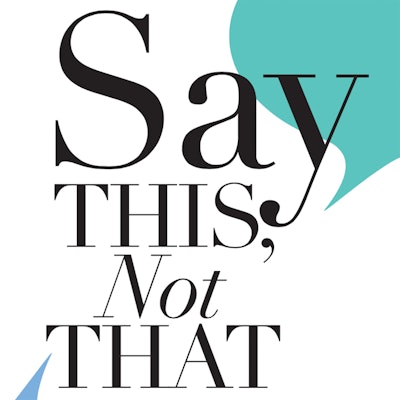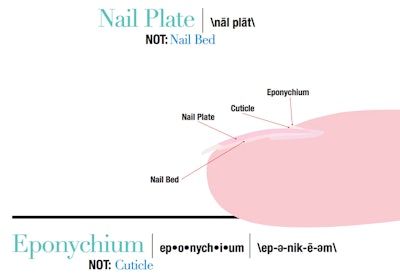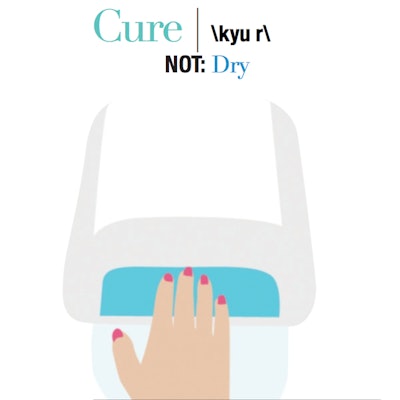
In an industry littered with misinformation, it’s exceedingly important to not only know what you’re talking about, but also be able to convey it correctly. As a licensed nail tech, you should be identifying nail anatomy, describing chemical processes and communicating sanitation procedures with detail and accuracy. After all, clients are looking to you to teach them. Unfortunately, even some of the most experienced nail techs sometimes use the wrong terminology, spreading falsehoods and projecting a less-than-professional image. To help, we’ve listed a few of the most commonly misused terms and asked experts to provide insight on why it’s important to say this and not that.

The terms “nail plate” and “nail bed” aren’t interchangeable. “This is basic human anatomy and not up for debate,” says Jill Wright, a nail tech and event coordinator for the Nail Tech Event of the Smokies in Gatlinburg, Tennessee. She often hears techs (and even educators!) misusing the two terms. “You don’t call the bones ‘skin’ or call the skin ‘bones’ because they are not the same, nor are they interchangeable,” she says. “They’re two different words with two different meanings, and they each serve a different purpose working in conjunction with each other—just like the nail plate and the nail bed do,” she says. The nail bed is the skin located under the nail plate. It contains blood vessels that supply nutrients to the fingertip. The nail plate is the hard keratin coating of the fingertip where techs do their work. In most cases, “nail plate” is the term techs should be using.
RELATED: 4 Ways to Make Your Salon More Eco-Conscious
“A widely misused term is ‘cuticle,’” says Allie Baker, EzFlow global brand ambassador. In fact, the common adage “Never cut the cuticle!” is technically incorrect. By repeating it, you’re perpetuating a myth and potentially making clients squirm when they see their tech pull out a pair of nippers. Instead, communicate to clients that you should never cut the eponychium, which is the visible “lip” of the proximal nail fold. This living skin protects the matrix from bacteria and should only be pushed back gently. “The cuticle is actually a thin transparent layer of dead tissue that emerges from under the eponychium,” explains Baker. Any cuticle remaining on the nail’s surface can interfere with adhesion of polish and enhancements, so removing it by cutting or filing is actually a best practice for most services.
Electric File | elec•tric | \i-lek-trik fī(- )l\ NOT: Drill
In the hands of a skilled nail technician, an electric file (or e-file) is a valuable tool that can be used to quickly reduce product bulk as well as prep, shape and smooth the nail. Calling an e-file a drill may invoke visions of construction workers boring holes into concrete—a scary thought for a client, says Vicki Malo, president of the North American School of Podology. “The term nail drill reminds me of woodworking tools!” she exclaims. “E-file sounds more professional and clients aren’t as afraid of it versus a drill.”

File this one in the “sounding professional” category. While the material removed from the underside of the toenail during a pedicure may indeed look funky or gunky, techs should never refer to it as such. “This material is actually skin buildup,” says Malo. While not all clients are easily offended, it’s not worth taking a chance. “Professional terminology always sounds better and helps the client understand what’s happening,” she says. This is also true for any potentially offensive condition, such as fungus or athlete’s foot. In these cases, Malo advises techs to use medical terminology, such as tinea pedis, instead.
PHOTOS: The Exhibitors at Our Annual Nail Show
Disinfect|dis•in•fect |\dis-in-fekt\ NOT: Sanitize, Clean or Sterilize
Don’t ease a client’s concern by assuring her that your implements are sanitized—because any knowledgeable client will run for the door! To sanitize simply means to kill a significant number of harmful bacteria on a surface to the point that a health professional would deem it nonthreatening. Sanitizing does not, in fact, remove any dirt or debris, a common misperception, explains Doug Schoon, president of Schoon Scientific and Regulatory Consulting in Dana Point, California. Cleaning offers the next level of protection and describes sanitizing, plus removal of contaminates, like oil and hair. To disinfect, an EPA-registered disinfectant is used after cleaning (always per the manufacturer’s instructions) to eliminate 99.9 percent of all remaining bacteria. Disinfection is the required standard for nail implements and tools and is most often the correct term techs should be using. Sterilization offers the highest level of protection from pathogens and isn’t required of nail techs—although some do. Use the word “sterilize” only if you’re removing all bacteria, viruses, fungi and spores with properly maintained sterilization equipment, such as an autoclave.

“When referring to gels and acrylics, the proper term to use is ‘cure,’” says Baker. In general, curing refers to a product reaching the appropriate hardness. Gel polish and standard gel enhancements cure as photo-initiators in the gel are activated by UV light (a process called polymerization), while acrylic hardens through a chemical reaction activated when the liquid monomer and powder polymer are mixed. The term “dry” describes the evaporation of moisture. The top layer of fresh nail polish dries quickly to the touch because it’s in direct contact with the air, which evaporates solvents contained in the polish.
Smooth | \smüt h\ NOT: Remove
“As nail technicians, it’s out of scope of practice to remove calluses or corns,” says Malo. “Instead, we reduce.” The distinction is small, but important. Not only does the term smooth or reduce better describe a tech’s effort, it also helps manage client expectations for their appointments. Techs can greatly improve the appearance of calluses and corns, which often has the added benefit of making the client more comfortable—but a client should never be led to believe he or she will leave the salon callus-free.
–Written by Leslie Henry











